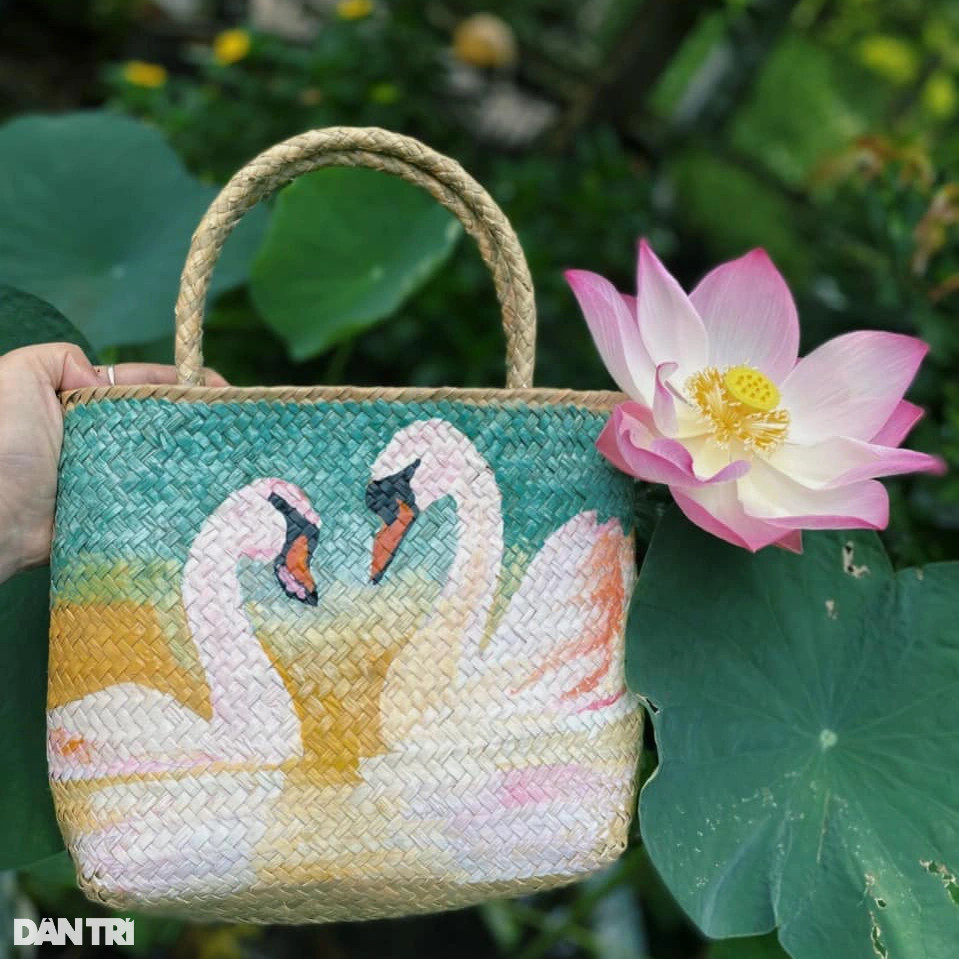The profession of weaving eagle grass developed, natural grass plants were not enough, so vast rice fields were also converted to grow eagle grass. The work gradually becomes specialized, in the hamlet there are people who only do the planting of almond grass, some people only process the grass and many people only do the weaving process.
Almond grass is fragile, only as big as the tip of a chopstick, its stem is hollow but taller than a person's head so it breaks easily. The grass is carefully harvested by people and arranged into neat bundles. After being dried in the sun for 3 days, it will be processed.
Dried grass will be selected, flattened manually or by machine and then transferred to the dyeing process. Each family working in the craft will have its own formula and secret to dyeing so that the product meets the standards desired by the knitting artisans.
After the dyeing step, the grass continues to be dried in the sun so that each blade of grass is shiny, making the product even more eye-catching. The final step is weaving the bamboo into products such as hats, bags, cushions...
"At first glance, knitting eagles is quite simple, there is no special formula, but in reality, the simpler it is, the more difficult it is to do. This is the most difficult step. The product of an experienced craftsman will look different from that of another craftsman. Product quality is distinguished by whether the knitting layers are even or uneven, tight or loose, rough or smooth joints.
The better the craftsman, the more small products he can knit, which are highly appreciated and the more valuable they are," shared Ms. Lai Thi Lien - a famous eagle knitter in Tan Ly Dong commune.
Ms. Lien's family has been weaving grass for four generations. A special feature is that this profession is only passed down through the female line. Her grandmother knew how to knit and taught Lien's mother, and now Lien is passing the profession on to her daughter. Ms. Lien said that weaving eagles does not make you rich, but it can help make your home full, so that husband and wife can be together warmly, without having to work hard to make a living.
In Tan Ly Dong commune, there are hundreds of families making bamboo weaving, some do it professionally, some do it part-time in their spare time. "When I was born, I saw my mother knitting and gradually learned to knit myself. I'm 53 years old but have nearly 50 years of experience. Knitting is not heavy, nor is it rushed. I'm free from work, busy on vacation, women stay at home to take care of it." If you're a housewife, you can also work part-time and earn money,' Ms. Lien said with a smile.
Exported goods "to the West"
However, the craft of weaving grass has also been challenged to the point of "suffocation". Ms. Lai Thi Hen (49 years old), owner of the largest grass production facility in Tan Ly Dong commune, recalls that in the early 2000s, when cheap industrial household appliances flooded the market, products made from almond grass became "weak", unable to compete again, many people working in this profession had to quit and become workers to make a living.
Desperate to keep her traditional profession, Ms. Hen took the trouble to go to Ho Chi Minh City to visit the "big market" to survey whether there was still land for herb grass products to sell or not.
"I went to meet big bag and hat shops to cooperate, but it was difficult. I even went to export businesses to make offers. When I learned that Europe, America or Japan all like handmade products, but they require With high quality and beautiful designs, I see "a bright door" and am determined to change to survive," Ms. Hen shared.
After returning from the survey, from just making traditional shopping baskets, Ms. Hen switched to making travel and fashion bags with diverse designs and eye-catching patterns. Products from grass also receive plus points for being environmentally friendly and are increasingly popular.
With her creative steps, Ms. Hen is considered the person who revived the bamboo weaving profession in the area. Currently, Ms. Hen's facility employs about 10 regular workers and cooperates in purchasing products for about 100 production households.
Having gone through many ups and downs, grass products have gone from being just items for poor families to now becoming "branded goods" on supermarket shelves in the West. The craft of weaving eagles has existed and is now growing, returning like a miracle.
(According to Dan Tri)





 Factory 1: Chuong My District, Hanoi Capital, Vietnam
Factory 1: Chuong My District, Hanoi Capital, Vietnam Factory 2: Kim Son District, Ninh Binh Province, Vietnam
Factory 2: Kim Son District, Ninh Binh Province, Vietnam (+84) 912 776 060 -
(+84) 912 776 060 -  sales@vietnamcraft.com.vn
sales@vietnamcraft.com.vn www.vietnamcraft.com.vn
www.vietnamcraft.com.vn




